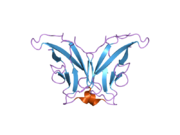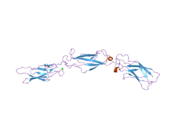Protein-coding gene in the species Homo sapiens
| CDH8 |
|---|
 |
| Available structures |
|---|
| PDB | Ortholog search: PDBe RCSB |
|---|
| List of PDB id codes |
|---|
1ZXK, 2A62 |
|
|
| Identifiers |
|---|
| Aliases | CDH8, Nbla04261, cadherin 8 |
|---|
| External IDs | OMIM: 603008 MGI: 107434 HomoloGene: 55604 GeneCards: CDH8 |
|---|
| Gene location (Human) |
|---|
 | | Chr. | Chromosome 16 (human)[1] |
|---|
| | Band | 16q21 | Start | 61,647,242 bp[1] |
|---|
| End | 62,037,035 bp[1] |
|---|
|
| Gene location (Mouse) |
|---|
 | | Chr. | Chromosome 8 (mouse)[2] |
|---|
| | Band | 8 D1|8 49.4 cM | Start | 99,751,103 bp[2] |
|---|
| End | 100,143,103 bp[2] |
|---|
|
| RNA expression pattern |
|---|
| Bgee | | Human | Mouse (ortholog) |
|---|
| Top expressed in | - endothelial cell
- Brodmann area 23
- prefrontal cortex
- entorhinal cortex
- middle temporal gyrus
- dorsolateral prefrontal cortex
- Brodmann area 9
- superior frontal gyrus
- nucleus accumbens
- pons
|
| | Top expressed in | - habenula
- globus pallidus
- dorsal tegmental nucleus
- ventral tegmental area
- medial dorsal nucleus
- lateral hypothalamus
- medial vestibular nucleus
- lateral geniculate nucleus
- mammillary body
- olfactory tubercle
|
| | More reference expression data |
|
|---|
| BioGPS |  | | More reference expression data |
|
|---|
|
| Gene ontology |
|---|
| Molecular function | - calcium ion binding
- metal ion binding
- identical protein binding
- cytoskeletal protein binding
- protein homodimerization activity
- cadherin binding
| | Cellular component | - axon terminus
- integral component of membrane
- synaptic cleft
- membrane
- plasma membrane
- synaptic membrane
- glutamatergic synapse
- cell surface
- catenin complex
| | Biological process | - response to cold
- cell adhesion
- adherens junction organization
- synaptic transmission, glutamatergic
- homophilic cell adhesion via plasma membrane adhesion molecules
- chemical synaptic transmission
- regulation of synapse organization
- cell-cell junction assembly
- calcium-dependent cell-cell adhesion via plasma membrane cell adhesion molecules
- cell-cell adhesion mediated by cadherin
- cell-cell adhesion
- cell morphogenesis
| | Sources:Amigo / QuickGO |
|
| Orthologs |
|---|
| Species | Human | Mouse |
|---|
| Entrez | | |
|---|
| Ensembl | | |
|---|
| UniProt | | |
|---|
| RefSeq (mRNA) | | |
|---|
NM_001039154
NM_001285913
NM_001285914
NM_007667 |
|
|---|
| RefSeq (protein) | | |
|---|
NP_001034243
NP_001272842
NP_001272843
NP_031693 |
|
|---|
| Location (UCSC) | Chr 16: 61.65 – 62.04 Mb | Chr 8: 99.75 – 100.14 Mb |
|---|
| PubMed search | [3] | [4] |
|---|
|
| Wikidata |
| View/Edit Human | View/Edit Mouse |
|
Cadherin-8 is a protein that in humans is encoded by the CDH8 gene.[5][6][7]
Function
This gene encodes a type II classical cadherin from the cadherin superfamily, integral membrane proteins that mediate calcium-dependent cell-cell adhesion. Mature cadherin proteins are composed of a large N-terminal extracellular domain, a single membrane-spanning domain, and a small, highly conserved C-terminal cytoplasmic domain. The extracellular domain consists of 5 subdomains, each containing a cadherin motif, and appears to determine the specificity of the protein's homophilic cell adhesion activity. Type II (atypical) cadherins are defined based on their lack of a HAV cell adhesion recognition sequence specific to type I cadherins. This particular cadherin is expressed in brain and is putatively involved in synaptic adhesion, axon outgrowth and guidance.[7]
Clinical significance
Disruptions of CDH8 in humans have been implicated in autism.[8][9]
References
- ^ a b c GRCh38: Ensembl release 89: ENSG00000150394 – Ensembl, May 2017
- ^ a b c GRCm38: Ensembl release 89: ENSMUSG00000036510 – Ensembl, May 2017
- ^ "Human PubMed Reference:". National Center for Biotechnology Information, U.S. National Library of Medicine.
- ^ "Mouse PubMed Reference:". National Center for Biotechnology Information, U.S. National Library of Medicine.
- ^ Kremmidiotis G, Baker E, Crawford J, Eyre HJ, Nahmias J, Callen DF (May 1998). "Localization of human cadherin genes to chromosome regions exhibiting cancer-related loss of heterozygosity". Genomics. 49 (3): 467–71. doi:10.1006/geno.1998.5281. PMID 9615235.
- ^ Suzuki S, Sano K, Tanihara H (Apr 1991). "Diversity of the cadherin family: evidence for eight new cadherins in nervous tissue". Cell Regulation. 2 (4): 261–70. doi:10.1091/mbc.2.4.261. PMC 361775. PMID 2059658.
- ^ a b "Entrez Gene: CDH8 cadherin 8, type 2".
- ^ Pagnamenta AT, Khan H, Walker S, Gerrelli D, Wing K, Bonaglia MC, et al. (Jan 2011). "Rare familial 16q21 microdeletions under a linkage peak implicate cadherin 8 (CDH8) in susceptibility to autism and learning disability". Journal of Medical Genetics. 48 (1): 48–54. doi:10.1136/jmg.2010.079426. PMC 3003876. PMID 20972252.
- ^ Brandler WM, Antaki D, Gujral M, Noor A, Rosanio G, Chapman TR, et al. (2016). "Frequency and Complexity of De Novo Structural Mutation in Autism". The American Journal of Human Genetics. 98 (4): 1–13. doi:10.1016/j.ajhg.2016.02.018. PMC 4833290. PMID 27018473.
Further reading
- Tanihara H, Sano K, Heimark RL, St John T, Suzuki S (Apr 1994). "Cloning of five human cadherins clarifies characteristic features of cadherin extracellular domain and provides further evidence for two structurally different types of cadherin". Cell Adhesion and Communication. 2 (1): 15–26. doi:10.3109/15419069409014199. PMID 7982033.
- Kido M, Obata S, Tanihara H, Rochelle JM, Seldin MF, Taketani S, Suzuki ST (Mar 1998). "Molecular properties and chromosomal location of cadherin-8". Genomics. 48 (2): 186–94. doi:10.1006/geno.1997.5152. PMID 9521872.
- Shimoyama Y, Tsujimoto G, Kitajima M, Natori M (Jul 2000). "Identification of three human type-II classic cadherins and frequent heterophilic interactions between different subclasses of type-II classic cadherins". The Biochemical Journal. 349 (Pt 1): 159–67. doi:10.1042/0264-6021:3490159. PMC 1221133. PMID 10861224.
- Blaschke S, Mueller CA, Markovic-Lipkovski J, Puch S, Miosge N, Becker V, Mueller GA, Klein G (Oct 2002). "Expression of cadherin-8 in renal cell carcinoma and fetal kidney". International Journal of Cancer. 101 (4): 327–34. doi:10.1002/ijc.10623. PMID 12209956. S2CID 7052911.
External links
 | This article on a gene on human chromosome 16 is a stub. You can help Wikipedia by expanding it. |

 1zxk: Crystal Structure of Cadherin8 EC1 domain
1zxk: Crystal Structure of Cadherin8 EC1 domain 2a62: Crystal structure of mouse cadherin-8 EC1-3
2a62: Crystal structure of mouse cadherin-8 EC1-3



















